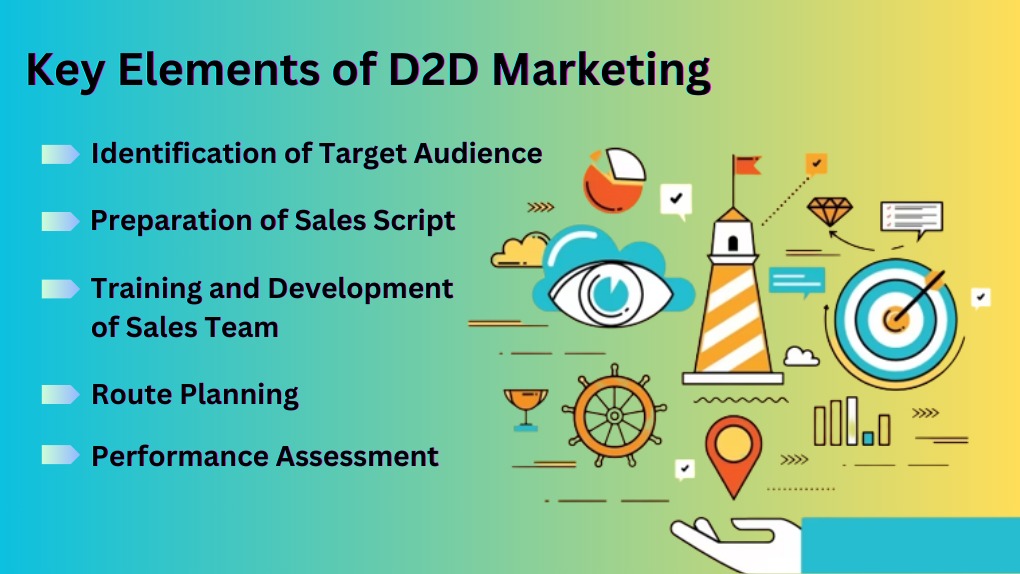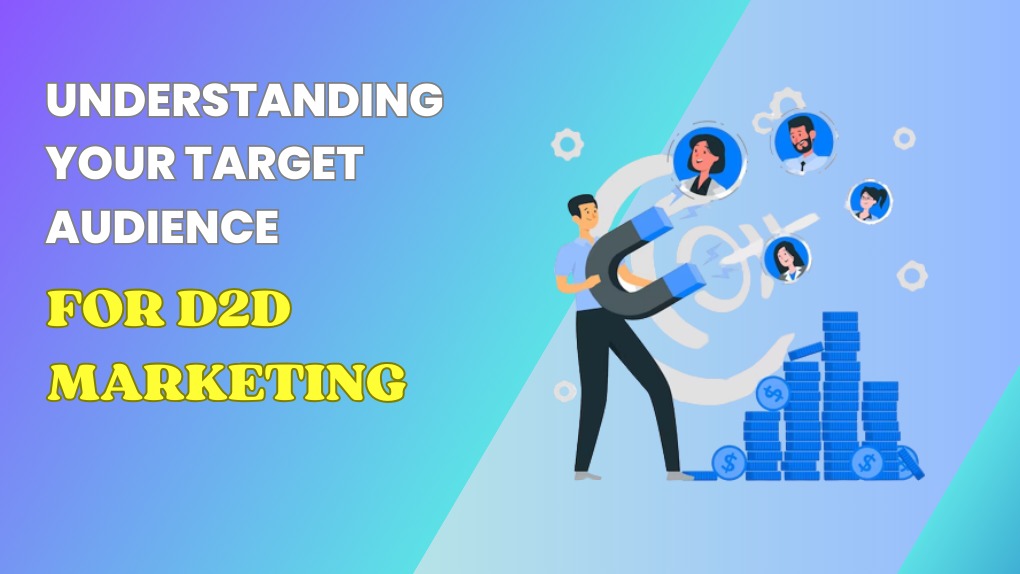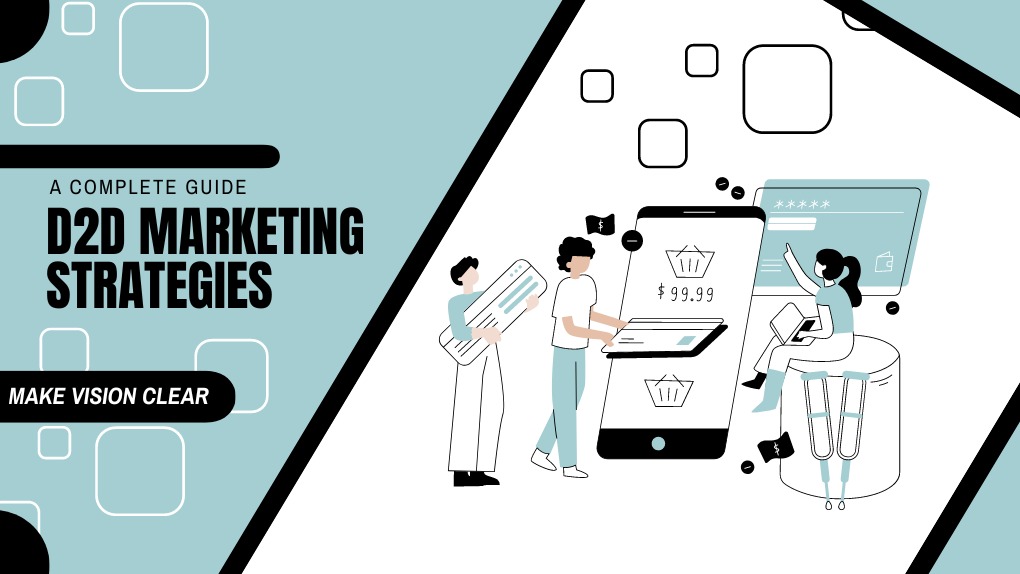Many businesses aiming to ramp up their online presence often overlook the tried and true method of door-to-door marketing, also known as D2D marketing.
Did you know that 76% of consumers have actually purchased a product or service after being approached by a salesperson at their doorstep?
This blog post is your go-to guide for leveraging D2D strategies in your business. We’ll break down the steps you need to take to not only boost your visibility but also to grow your customer base. Ready to shake things up? Let’s sail into it.
Table of Contents
What is D2D Marketing?
D2D, or Door-to-Door marketing, is a direct sales strategy where sales representatives or marketers reach out directly to potential customers at their residences or workplaces.
This strategy rests on the principle of personal selling and is characterized by face-to-face interactions that aim to drive sales, generate leads, and foster robust customer relations.
The D2D marketing strategy is versatile and can be employed by both B2B and B2C businesses.
Although it seems traditional and perhaps outdated in the digital industry, D2D marketing retains its relevance. It offers an engaging, highly personalized approach that can’t be replicated by digital platforms.
Because of its face-to-face nature, it enables marketers to build trust, thoroughly explain their products or services, and immediately address any objections or questions the prospect may have.
However, to effectively implement a D2D marketing strategy, businesses must understand its unique dimensions and potential challenges. These include the need for a well-trained sales force, the demands of travel and logistics, and the importance of respecting the customer’s personal space and time.
See also: Top 8 AI Tools to Write Optimized Content in 2023
Key Elements of D2D Marketing

Door-to-Door (D2D) marketing is a direct sales technique that involves promoting products or services to consumers at their homes or workplaces. It’s a strategy that requires careful planning, execution, and management to be successful. Here, we delve into the key elements that constitute a proficient D2D marketing strategy.
Identification of Target Audience
The first step in a successful D2D strategy is identifying your target audience. This involves demographic profiling, understanding their preferences, behavior and buying patterns. The products or services being promoted should meet the specific needs of this target audience.
Preparation of Sales Script
A well-prepared and effective sales script is a vital tool in D2D marketing. The script should be designed to engage the customer, address their needs, and present your product or service as the solution. It should be conversational, yet persuasive, and include room for objection handling.
Training and Development of Sales Team
The sales team is the face of your company in D2D marketing. Hence, proper training and development are crucial. They should be well-versed in the product or service, skilled at initiating conversations and closing sales, and equipped to handle objections. Their interpersonal skills can make or break the success of the strategy.
Route Planning
Route planning is an essential organizational aspect of D2D marketing. It involves strategizing the areas to be covered by the sales team, ensuring they are accessible, and align with the target audience’s demographics. Efficient route planning can increase productivity and save valuable time.
Performance Assessment
To gauge the success of your D2D marketing strategy, performance assessment is a must. This involves monitoring sales, tracking conversions, and assessing customer feedback. Not only does this help measure the success of your strategy, but it also identifies areas for improvement to optimize future efforts.
Understanding Your Target Audience for D2D Marketing

Understanding your target audience is the foundation of any successful Door-to-Door (D2D) marketing campaign. It’s crucial to know who your potential customers are, what they need, their preferences, and how your product or service can solve their problems. This knowledge will help you tailor your sales pitch, making it more effective and engaging.
Defining Your Target Audience
Defining your target audience involves segmenting the market based on various characteristics such as demographics, geographic location, psychographics, and behavior. These factors significantly influence purchasing decisions and, when put into consideration, you can tailor your products or services to meet specific needs.
Geographic Segmentation
Geographic segmentation involves categorizing potential customers based on their physical location. This could be at the national, regional, state, city, or even neighborhood level. Based on the location, you can identify the specific needs and preferences unique to those areas and tailor your offerings accordingly.
Demographic Segmentation
Demographic segmentation is about categorizing your potential customers based on demographic variables such as age, gender, income level, education level, marital status, occupation, and ethnicity. These factors can significantly influence an individual’s buying behavior, and understanding them can help you create a sales pitch that resonates with your target audience.
Psychographic Segmentation
Psychographic segmentation involves grouping potential customers based on their lifestyle, attitudes, values, personality, and social status. This type of segmentation can be incredibly useful in D2D marketing, as it can help you understand your audience’s motivations and concerns, allowing you to create a more personalized and effective sales pitch.
Behavioral Segmentation
Behavioral segmentation categorizes potential customers based on their behavior, including their buying habits, brand interactions, spending habits, and product usage rates. By understanding these behaviors, you can identify patterns and trends that can help you tailor your D2D marketing strategy to match your audience’s preferences and needs.
In summary, Defining your target audience is a critical first step in creating an effective D2D marketing strategy. By segmenting your market based on geographic, demographic, psychographic, and behavioral factors, you can better understand your potential customers and design a sales pitch that effectively appeals to their needs and preferences.
See also: What Is Parasite SEO? How to Leverage It for Success
Strategies for Developing an Effective D2D Marketing Plan
Developing an effective door-to-door (D2D) marketing plan is a complex process that demands strategic thinking, careful planning, and robust implementation. Here are some strategies that can steer your D2D marketing efforts toward success.
1. Comprehensive Market Research
Start with in-depth market research. Understand your target audience, their needs, challenges, and preferences. This information is crucial in tailoring your marketing message and strategy. Use both primary and secondary research methods to collect data and gain insights. Primary research could include surveys, interviews, and focus groups, while secondary research might involve studying industry reports, competitor strategies, and online resources.
2. Clear and Consistent Messaging
Once you’ve identified your target audience and their needs, craft your marketing message. This should be clear, concise, and consistently delivered across all your marketing channels. Your message should communicate the value of your product or service to the customer, addressing their needs or solving their problems.
3. Comprehensive Training of Sales Representatives
Invest in comprehensive training of your sales team. They should be well-versed with your product or service, the marketing message, and the sales script. Teach them effective communication and persuasion skills. Remember, they are the face of your brand in D2D marketing, their performance directly impacts your business.
4. Effective Route Planning
Route planning is crucial in D2D marketing. Identify the areas where your potential customers live and plan the route in such a way that your team covers maximum houses in minimum time. Use route planning software to optimize the process.
5. Regular Performance Assessment and Feedback
Regularly assess the performance of your sales team. Conduct meetings, review their performance, and provide constructive feedback. Use key performance indicators (KPIs) to measure their success. Some KPIs could be the number of doors knocked, leads generated, or sales closed. This helps in identifying areas of improvement and implementing corrective measures.
Each of these strategies plays a vital role in the success of your D2D marketing plan. It’s important to remember that while these strategies can guide you, there is no one-size-fits-all approach in D2D marketing. Continually evaluate and tweak your strategy based on the feedback and data you collect along the way.
See also: Top 7 Ways Machine Learning Takes Digital Marketing To The Next Level
Crafting Your D2D Marketing Message to Maximize Impact
The final piece of the D2D marketing puzzle is crafting a compelling and persuasive marketing message. A powerful message can be influential in capturing your audience’s attention, persuading them to engage with your product or service, and fostering lasting relationships. It is the core of your D2D marketing strategy, encapsulating the essence of what you are offering and why it matters to your target audience.
Understanding the Customer’s Needs
Understanding your customer’s needs and pain points is the cornerstone of crafting a powerful marketing message. It enables you to communicate how your product or service can solve their problem or fulfill their wants. Moreover, it allows you to position your product or service as a solution, creating a compelling reason for the potential client to entertain your pitch.
Presenting the Unique Selling Proposition (USP)
Once you have a clear understanding of your customer’s needs, the next step is to articulate your unique selling proposition (USP). This is the distinctive advantage that sets your product or service apart from the competition.
It could be superior quality, a unique feature, exceptional service, or any other attribute that adds unique value to your offering. Highlighting your USP in your marketing message helps you to differentiate your brand and establish a distinctive market position.
Structuring the Marketing Message
Effective marketing messages are typically structured in three parts: the hook, the line, and the sinker. The ‘hook’ is an attention-grabbing statement or question designed to pique the customer’s interest. The ‘line’ is the main body of the message, providing more details about the product or service and its benefits. The ‘sinker’ is the closing statement, designed to stimulate action. This could be an invitation to see a demonstration, a time-limited offer, or another call to action that encourages immediate response.
Delivering the Message
The delivery of the message is equally important as the content. It involves the salesperson’s verbal and non-verbal communication, including tone of voice, body language, and rapport-building skills. A confident, friendly, and empathetic salesperson can significantly enhance the effectiveness of a marketing message. Similarly, ensuring that the message is delivered in a casual and conversational tone can make the customer feel more comfortable and open to the sales pitch.
See also: SEO vs SEM: Which is Right for Your Business?
The Importance of Training Your D2D Marketing Team
The success of any D2D marketing campaign lies fundamentally in the hands of the sales representatives who are on the field interacting directly with potential customers. Therefore, investing in a thorough and comprehensive training program for your D2D marketing team is not just an add-on, but a critical requirement.
Developing Skills and Knowledge
Training equips your team with essential skills and knowledge that they need to execute their roles effectively. This includes understanding the product or service they are selling, knowing the target market, mastering sales techniques, and being able to handle objections and questions from customers. Without this foundation, even the most strategic D2D marketing plan can fail to yield the desired results.
Building Confidence and Enhancing Motivation
Training also plays a critical role in building confidence among sales representatives. When they know what they are talking about and how to handle different situations, they are more likely to approach potential customers with confidence. Moreover, training can serve as a motivator, especially when it is interactive, engaging, and directly tied to the success of the representative in their role.
Ensuring Consistency
D2D marketing involves direct interaction with customers, and therefore, consistency in the way your brand is represented is key. Training ensures that all members of your team are on the same page about the brand, product, and the standards of customer interaction. This guarantees that regardless of who the customer talks to, they get the same quality of interaction and information.
Adapting to Change
Finally, the business environment and consumer behavior are always changing. Regular training helps your D2D marketing team stay up-to-date with these changes and adapt their approaches accordingly. This could be changes in marketing regulations, shifts in market trends, or new competitive strategies.
Lastly, training is not merely an activity you conduct once and forget about. It is a continuous process that should be ingrained in your D2D marketing strategy. Regularly investing in training not only equips your team with the tools they need for success but also signals to them that the organization values their personal and professional growth.
Tips for Managing Successful D2D Marketing Campaigns
successful Door-to-Door (D2D) marketing campaigns require strategic planning, effective execution, and continuous monitoring. Here are some insightful tips that can guide businesses in implementing and managing successful D2D marketing campaigns.
1. Set Clear Objectives
Before setting out, it is vitally important to have clear objectives for your D2D marketing campaign. These objectives should be S.M.A.R.T (Specific, Measurable, Achievable, Relevant, and Time-Bound). The objectives set the direction and tone of your campaign and help you measure its success.
2. Prioritize Customer Experience
D2D marketing is all about personal interaction with customers. Therefore, ensuring a positive customer experience should be a key priority. This includes polite and respectful interactions, responding to customer queries effectively, and maintaining professionalism at all times.
3. Use Technology for Efficiency
Embrace technology to enhance the efficiency of your D2D marketing campaign. This could involve using GPS for route planning, CRM systems for customer relationship management, or mobile apps for real-time tracking of sales activities. Technology can greatly optimize your operations, save time, and reduce costs.
4. Monitor and Adjust the Campaign Regularly
Continuous monitoring of your campaign’s performance is crucial to its success. This requires setting key performance indicators (KPIs) and tracking them regularly. If the campaign is not delivering as expected, don’t hesitate to adjust your strategies or take corrective actions.
5. Provide Ongoing Training and Support to Your Sales Team
Remember, your sales team is the face of your company in D2D marketing. Ensuring they have the necessary skills and knowledge to perform effectively is vital. Regular training and support can boost their motivation and performance, leading to better campaign results.
6. Respect Local Laws and Regulations
Finally, it’s important to respect local laws and regulations related to D2D marketing. This includes obtaining necessary permits, respecting no-soliciting zones, and adhering to designated soliciting hours. Not only is this ethically correct, but it also helps build trust and credibility with your customers.
Measuring the Success of Your D2D Marketing Efforts
The success of your D2D marketing efforts is not just about how many doors your sales team knocks on, but the quality of interactions and conversions that result from those encounters. Therefore, it’s crucial to measure your success accurately to fully understand the return on your investment and to make informed decisions for future strategies.
Key Performance Indicators (KPIs)
Identifying the right Key Performance Indicators (KPIs) is a critical part of measuring the success of any marketing campaign. For D2D marketing, your KPIs might include:
- Conversion Rate: This is the percentage of prospects that become customers. To calculate, divide the number of sales made by the total number of potential customers engaged.
- Closing Ratio: The ratio of successful sales to the number of pitches made.
- Customer Acquisition Cost: This is the total cost of obtaining a new customer, including all marketing and sales costs.
- Customer Lifetime Value: An estimation of the total value a customer brings to your business over the entirety of their relationship with you.
Customer Satisfaction
Although not a quantitative metric, customer satisfaction plays a vital role in measuring the success of your D2D marketing efforts. Happy customers are more likely to be loyal and refer your business to others, driving organic growth. You can gauge customer satisfaction through surveys, reviews, and feedback from social media channels.
Regular Reporting and Analysis
Regular reporting and analysis of your D2D marketing metrics are essential to understanding the effectiveness of your strategies. This process involves collating data, interpreting the results, and then making necessary adjustments to improve performance. Remember, what gets measured gets managed, so keep your finger on the pulse of your performance indicators.
Taking Action on Insights
Merely measuring your success is not enough — you must take action on the insights you glean. Use your findings to refine your marketing strategy, improve your sales script, retrain your sales team, or make other necessary adjustments. The ultimate goal of measuring your marketing efforts is continuous improvement.
To sum up, successful D2D marketing is a result of strategic planning, execution, and regular measurement. By paying attention to your KPIs, customer satisfaction, and taking action on insights, you can elevate your D2D marketing to new heights.
See also: Top 8 AI Tools to Write Optimized Content in 2023
Overcoming Common Challenges in D2D Marketing
Understanding the potential challenges in D2D marketing is crucial for businesses to optimize their strategies effectively. Let’s delve into some of the common obstacles and how your business can address them.
1. Rejection and Resistance from Potential Customers
One of the most significant challenges faced in D2D marketing is the potential rejection or resistance from customers. This could stem from a lack of interest, skepticism towards the product or service, or simply the inconvenience of an unsolicited visit. To overcome this, sales representatives should be trained to handle rejection professionally, focusing on maintaining a positive demeanor and moving on to the next potential customer. Additionally, ensuring your marketing message is compelling, clear, and tailored to the needs of the customer can significantly reduce resistance.
2. High Turnover of Sales Staff
High turnover of sales staff is a significant challenge that businesses often face in D2D marketing. The nature of the job, which involves constant traveling, facing rejections, and working under uncertain weather conditions, can lead to employee burnout and dissatisfaction, resulting in a high attrition rate.
Addressing this issue requires a strategic approach that centers on creating a supportive work environment and providing incentives that motivate and retain employees.
3. Employee Training and Development
Investing in comprehensive training and development programs is crucial. Equip your sales team with the necessary skills and knowledge to perform their job effectively. Continuous learning opportunities can also boost their morale and job satisfaction, reducing the likelihood of them leaving the company.
4. Competitive Compensation
Ensure that your sales team is appropriately compensated for their efforts. This doesn’t only mean a satisfactory base salary, but also commission structures that reward high performance. Providing monetary incentives can motivate them to improve and stay with your organization for a longer period.
5. Supportive Work Environment
Creating a supportive work environment is equally important. Encourage open communication where your sales team can express their challenges and provide feedback. This not only helps in resolving issues promptly but also fosters a culture of mutual respect and understanding.
6. Recognition and Rewards
Recognize and reward your sales staff for their achievements. This could be through simple gestures like a ‘Salesperson of the Month’ award, or more substantial rewards like vacation packages for the top performers. Recognition can significantly boost employee morale and motivation, reducing turnover rates.
Remember, the sales team is the face of your D2D marketing strategy. Their satisfaction and performance directly impact the success of your marketing efforts. Therefore, managing staff turnover effectively is integral to the overall success of your D2D marketing campaign.
See also: How to Make Money Fast: 7 Strategies to Boost Your Income
Conclusion
Door-to-door (D2D) marketing still carries significant potential in today’s dynamic business environment, particularly when executed with a well-structured and effective strategy. It requires meticulously identifying and understanding the target audience, crafting a persuasive and impactful marketing message, and training a motivated and skilled sales team.
It’s imperative to be prepared to navigate through the challenges, including customer rejection, high staff turnover, and the need for continuous training. Leveraging technology, maintaining regulatory compliance, and prioritizing customer experience can help businesses manage successful D2D marketing campaigns.
Performance assessment is crucial in determining the success of the D2D marketing efforts. Key Performance Indicators (KPIs), customer satisfaction, and regular reporting provide a quantitative and qualitative basis for this. Based on these insights, businesses can make informed decisions to tweak and improve their D2D strategies for better results.
Despite the dominance of digital media, D2D marketing remains a valuable tool for businesses, helping them to engage customers on a more personal and impactful level. By adopting the right strategies and practices, businesses can optimize their D2D marketing efforts for enhanced customer acquisition, retention, and overall business growth.



